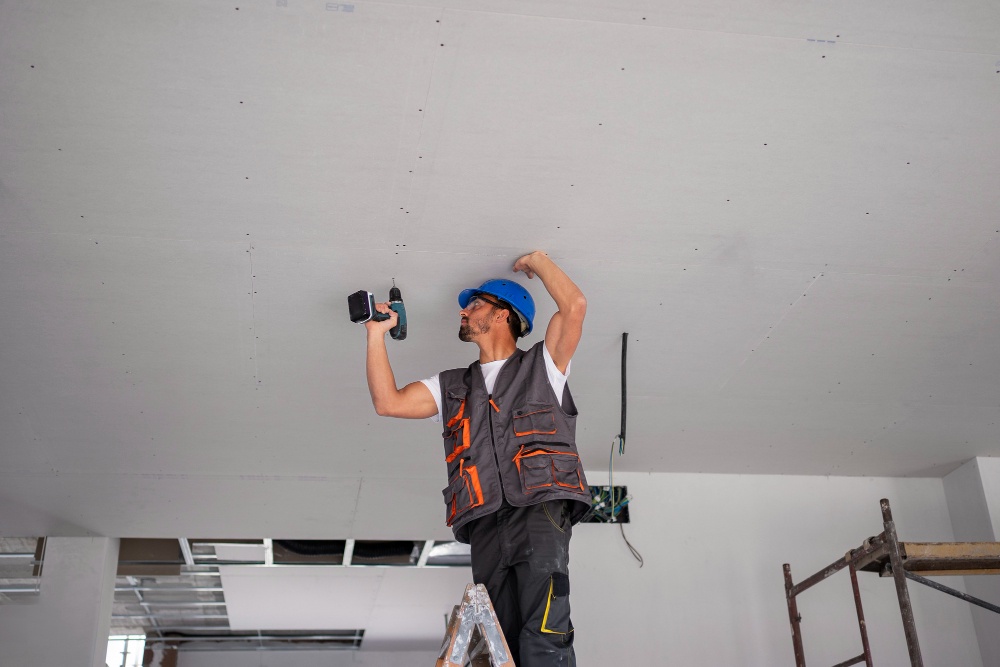Every homeowner knows that the walls of a house, though they might look robust and invincible, can also suffer wear and tear. Whether it's a slight dent, a big hole, or cracks, the typical go-to solution is to call in drywall repair services.
If you've ever been curious about what these professionals do or what considerations go into fixing a wall, you're in luck. This post dives deep into the most common considerations for drywall repair.
Determining the Extent of Damage
Before diving into any repair, the first step for drywall repair services is to evaluate the extent of the damage. Not all wall damage is the same, and understanding its depth and severity can significantly impact the approach and materials used.
- Superficial damage. This might seem insignificant, but small dents, scuffs, or minor cracks can affect the aesthetics of a room. Often the result of accidental bumps, moving furniture, or everyday wear and tear, these can be quickly fixed without much hassle. However, left untreated, they can become focal points that draw undue attention.
- Moderate damage. More pronounced than the superficial ones, damages like holes the size of a fist or long cracks that traverse the wall are categorized as moderate. These damages might be due to incidents like doors swinging open with too much force or larger accidents within the home. They require more attention and may need patching or reinforcement.
- Severe damage. These are the most concerning, involving large holes or even structural damage. Causes could range from water damage, significant accidents, or foundational shifts in the building. In these cases, it's crucial to consult with professional drywall repair services promptly, as a portion of the drywall may need a complete replacement, and the underlying cause of the damage must be addressed.
Choosing the Right Materials
The right tools and materials make all the difference in ensuring a repair is durable and seamless. Drywall itself comes in various thicknesses and types, and understanding where and when to use each type is essential for a successful repair.
- Regular drywall. This is the most common choice, suitable for most home repairs. It's versatile, easy to work with, and blends seamlessly with most wall constructions.
- Moisture-resistant drywall. As the name suggests, this type of drywall is designed specifically for areas prone to moisture. Bathrooms, laundry rooms, or basements, where there's a higher chance of moisture accumulation, benefit from this type. By using moisture-resistant drywall, homeowners can mitigate the risks of mold and moisture damage.
- Fire-resistant drywall. Although more commonly used in commercial settings, this type of drywall can be considered for homes as well, especially in areas near fireplaces or kitchens. Fire-resistant drywall adds an extra layer of safety by slowing the spread of fires, potentially giving residents more time to evacuate and minimizing damage.
Choosing the right kind of drywall isn't just about addressing the present damage. It's also about preempting future issues and ensuring that repairs last for a long time. By consulting with knowledgeable drywall repair services, homeowners can get expert advice on the best materials for their unique situation.
Patching vs. Replacement
When faced with damaged drywall, homeowners often confront the dilemma of whether to patch the damaged area or opt for a complete replacement. This decision isn't just about aesthetics; it's also about the integrity of the wall and the future resilience of the repair.
Patching
Patching is typically the go-to method for moderate damages. This involves placing a patch over the damaged section, and then plastering or "mudding" over it to create a seamless appearance. Patching is less invasive and usually quicker than full replacement. It's ideal for those damages that haven't affected the integrity of the wall, such as small to medium-sized holes or surface cracks.
However, while patching is effective for minor to moderate issues, it's essential to ensure that the root cause of the damage is addressed. For instance, if a water leak caused damage, merely patching without fixing the leak will only lead to recurring problems.
Replacement
In instances where the damage is more severe, or where there's a concern about the structural integrity of the wall, replacement might be the best route. This method involves removing the damaged section of the drywall entirely and installing a new piece in its place.
While this process is more labor-intensive and could be costlier, it provides an opportunity to inspect the underlying structures, like insulation and wiring, and address any hidden issues.
Replacement ensures that your wall isn't just aesthetically pleasing but is also robust and capable of withstanding future wear and tear.
Paint and Finish Matching
Once the drywall repair is complete, the next step is to ensure that the repaired section blends seamlessly with the rest of the wall. This is where the art and skill of paint and finish matching come into play.
Matching the original paint color can be a bit of a challenge, especially if the existing paint has faded over time or if the homeowner no longer has a record of the original shade.
Drywall repair services often utilize advanced color-matching technologies to recreate the exact hue. This might involve taking a small sample of the existing wall color and matching it in-store. Sometimes, for the best consistency, professionals might suggest painting an entire wall or room, especially if the color difference is noticeable.
Beyond color, walls often have unique textures: be it a stippled, orange peel, or knockdown finish. Replicating these textures requires a keen eye and a skilled hand. Professionals utilize various tools and techniques to mimic the original texture, ensuring that the repaired section doesn't stand out.
It's this attention to detail that makes professional drywall repair services invaluable. The goal is to make it seem as though the damage never occurred, creating a uniform and cohesive appearance throughout.
Preventive Measures for Future Damages
When it comes to our crafting homes, prevention is always better than cure. Drywall repair services often emphasize the importance of measures to ensure that once the wall is repaired, it stays that way for as long as possible.
For instance, ensuring sturdy installations is paramount. If you're hanging heavy items like TVs, art pieces, or shelves, it's crucial to secure them properly to the wall. This doesn't just ensure the longevity of the item you're mounting but also prevents any undue stress on the drywall, which could lead to cracks or holes.
Moreover, it's a good idea to adopt the habit of regular wall inspections. Periodically take a walk through your rooms and check for signs of wear and tear. Early detection can be the difference between a small, easy-to-fix dent and a larger, more complex repair job. Taking care of minor damages as they arise can save both time and money in the long run.
The Cost Factor
One of the undeniable realities homeowners face when considering any form of repair is the cost. Drywall repair is no different. While the immediate thought is about the extent of the damage and how it influences the bill, several underlying factors contribute to the overall cost of the repair with Quantify North America.
Materials, for one, play a significant role. Different drywalls and finishes come with varied price tags. While it might be tempting to opt for a cheaper alternative, it's essential to remember that quality materials generally offer more extended durability, which could lead to savings in the long run.
Professional expertise also has a price. Some homeowners might consider taking on a drywall repair as a DIY project to save on service costs. However, the value that professional drywall repair services bring to the table, in terms of expertise, precision, and often guarantees on their work, means that the job is done right the first time. This can potentially prevent repeat repairs and the accompanying costs.
Taking these factors into account, it becomes clear that while the initial outlay for quality repairs might seem high, the long-term benefits in terms of durability and peace of mind often justify the investment.
Conclusion
Drywall, like any other component of a house, requires maintenance and occasional repairs. By understanding the common considerations of drywall repair, homeowners can make informed decisions when it's time to call in professionals. Remember, quality drywall repair services will not only address the immediate issue but also offer solutions that prevent future damage, ensuring your walls remain pristine for years to come.


No comments yet